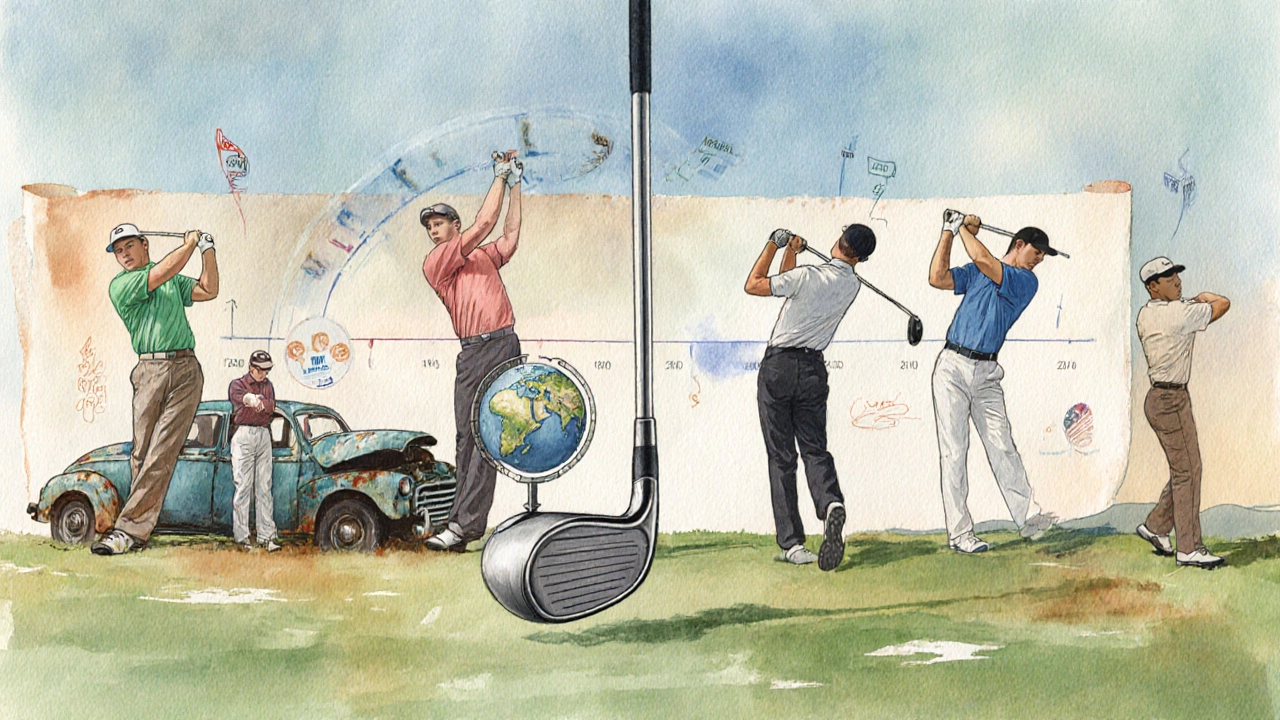Who Is the Greatest Golfer of All Time? Ranking the Legends
 Oct, 22 2025
Oct, 22 2025
Golfer Greatness Calculator
Custom Weighting
Set your priorities for what makes a golfer "greatest":
How It Works
Major Championships: The four majors (Masters, U.S. Open, The Open Championship, PGA Championship) are golf's ultimate tests.
PGA Tour Wins: Consistent week-in-week-out success shows durability and dominance.
Intangible Influence: Media impact, growth of the game, and clutch moments that inspire future generations.
Tip: Adjust your weights to see how different criteria affect the results. Try setting Majors to 60% and Wins to 25% to see how it impacts the ranking.
Your Greatest Golfer
Score Breakdown
Key Statistics
Quick Takeaways
- Jack Nicklaus holds the most major titles (18) but Tiger Woods leads in total PGA Tour wins (82).
- Longevity, impact on the sport, and clutch performance each tip the scales differently.
- Statistical dominance favors Woods, while Nicklaus’s major record remains unmatched.
- Modern analytics show both players excel in different eras, making "greatest" a nuanced debate.
- Consider what matters most to you - majors, earnings, influence - before picking a favorite.
Fans argue, pundits tweet, and historians write books - all to answer a single, stubborn question: who is the greatest golfer of all time? The answer isn’t a simple name drop. It depends on the criteria you value most and how you weigh eras that differ in technology, course design, and competition depth. This guide breaks down the most common metrics, compares the top legends side‑by‑side, and walks you through the intangible factors that numbers alone can’t capture.
Tiger Woods is a five‑time Master’s champion, 15‑time major winner, and holder of 82 PGA Tour victories, tying the all‑time record. His meteoric rise in the late 1990s reshaped the sport’s popularity, drawing new fans and sponsors worldwide. His career, however, includes injury‑filled valleys and a public comeback that adds drama to his statistical dominance.
Jack Nicklaus is the "Golden Bear," winner of 18 major championships - the most in golf history - and a record 73 PGA Tour victories. Nicklaus’s steady, methodical style made him a model of consistency across decades, and his record in majors has stood untouched for nearly half a century.
Other legends also merit a deep look. Arnold Palmer is the charismatic "King of the Hill" who won seven majors and helped launch the modern TV era of golf. Ben Hogan is renowned for his flawless ball‑striking and five major titles, despite a career‑ending car accident in 1949. Gary Player is the South African powerhouse with nine majors and a global ambassadorial presence. Phil Mickelson is the left‑handed “Willy Wonka” who captured five majors well into his 50s. Finally, Rory McIlroy is the modern phenom with four majors and a reputation for power and precision. All of them left indelible marks on the game, but they shine in different ways.
How We Measure Greatness
Before we rank the legends, we need a clear yardstick. The most common metrics fall into three buckets:
- Major Championships - The four majors (The Masters, U.S. Open, The Open Championship, PGA Championship) are the sport’s ultimate tests.
- PGA Tour Wins & Career Earnings - Consistent week‑in‑week‑out success shows durability and dominance.
- Intangible Influence - Media impact, growth of the game, and clutch moments that inspire future generations.
Each bucket has its own weighting. Purists often give majors 50% of the score, while analysts who love data may tilt toward total wins and earnings (30%). The remaining 20% is reserved for intangible factors - a blend of cultural impact and performance under pressure.
Statistical Showdown
| Golfer | Major Wins | PGA Tour Wins | Career Earnings (USD) | Years on Tour | Iconic Moment |
|---|---|---|---|---|---|
| Tiger Woods | 15 | 82 | ~$120 million | 1996‑2024 | 1997 Masters - 12‑under‑par finish |
| Jack Nicklaus | 18 | 73 | ~$15 million (inflation‑adjusted > $150M) | 1961‑1986 | 1986 Masters - “the shot heard ’round the world” |
| Arnold Palmer | 7 | 62 | ~$10 million | 1954‑1971 | 1960 Open - “the charismatic champion” |
| Ben Hogan | 9 | 64 | ~$8 million | 1930‑1961 | 1953 U.S. Open - comeback after auto crash |
| Gary Player | 9 | 71 | ~$12 million | 1957‑1979 | 1965 Masters - first non‑American winner |
| Phil Mickelson | 5 | 45 | ~$99 million | 1992‑2024 | 2004 Masters - dramatic chip‑in |
| Rory McIlroy | 4 | 28 | ~$55 million | 2009‑Present | 2011 U.S. Open - 8‑under‑par wire‑to‑wire |
When you stare at the numbers, a pattern emerges. Woods leads in total wins (both majors and PGA Tour) and earnings, whereas Nicklaus still owns the major crown. Palmer and Player excelled in popularizing the sport, a factor that doesn’t show up as cleanly on a spreadsheet.

Beyond the Numbers: Intangible Influence
Data can tell you who won the most, but it can’t fully capture why a player mattered. Consider these softer metrics:
- Global Reach: Woods’s TV ratings in the early 2000s were higher than any previous golfer, pulling in new demographics and sponsors.
- Course Innovation: Nicklaus designed over 400 courses, shaping how modern venues are built and played.
- Fan Connection: Palmer’s “Arnie’s Army” was the first true fan movement, pre‑social‑media era.
- Resilience: Hogan’s comeback after a near‑fatal accident set a standard for mental toughness.
- Longevity: Mickelson’s major win at age 50 (2021 PGA) demonstrates ageless competitiveness.
Each of these factors contributes to the mythos that fans attach to a name. The "greatest" title often reflects the story you grew up hearing, not just statistical superiority.
How the PGA Tour the premier professional golf circuit in the United States, hosting most of the world’s top events Weighs In
The PGA Tour’s official rankings (FedExCup points) give us another lens. Woods topped the points list seven times, more than any other player. Nicklaus never played the modern FedExCup format, but his era’s money list dominance is comparable.
When you combine FedExCup points, majors, and earnings, the composite score still edges toward Woods, but not by a massive margin. That tells us the debate is tightly contested, and any final answer will hinge on personal weighting.

Putting It All Together: A Decision Framework
If you’re trying to pick your personal "greatest golfer," use this quick framework:
- Set Your Priorities: Do majors matter most? Or total wins? Maybe cultural impact?
- Assign Percentages: Example - Majors 50%, Wins 30%, Influence 20%.
- Score Each Legend: Use the table above for raw numbers, then apply your weightings.
- Adjust for Era: Inflation‑adjust earnings, consider equipment advances, and factor course difficulty changes.
- Make Your Call: The highest weighted score wins your title.
Running this exercise with a 50/30/20 split gives Nicklaus a slight edge because his major count outweighs Woods’s win total. Flip the weights to 40/40/20, and Woods takes the crown.
Final Thoughts (But No Final Answer)
The beauty of sports is that the "greatest" conversation never truly ends. New generations will keep adding fresh names - maybe someone will break both Nicklaus’s major record and Woods’s win total within the next decade.
What matters is that each legend pushed the game forward, inspired fans, and left a lasting footprint. Whether you cheer for the calculated dominance of Tiger Woods or the timeless major mastery of Jack Nicklaus, you’re part of a tradition that celebrates excellence above all.
Who has won the most major championships?
Jack Nicklaus holds the record with 18 major titles, followed by Tiger Woods with 15.
Which golfer has the most PGA Tour wins?
Tiger Woods and Sam Snead share the record at 82 PGA Tour victories each.
How do equipment changes affect cross‑era comparisons?
Modern clubs and balls travel farther and are more forgiving, so older players often faced tougher conditions. Adjusting for technology usually narrows the gap between early legends and today's stars.
Did any golfer design courses?
Jack Nicklaus has designed over 400 courses worldwide, influencing layout, strategy, and difficulty for future competitions.
Who was the first international player to win a major?
Gary Player became the first non‑American to claim a major when he won the 1959 British Open, later adding three more majors.